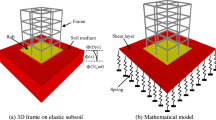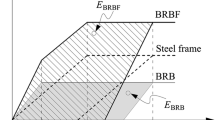Abstract
A cluster-based non-dominated sorting genetic algorithm (NSGA) II has been considered to investigate the effects of rehabilitation objectives on multi-objective design optimization of two-dimensional (2D) steel X-braced frames in the presence of soil-structure interaction. The substructure elasto-perfect plastic model has been adopted for modeling of the soil-structure interaction and the nonlinear pushover analysis is used to evaluate the performance level of the frames for a specified hazard level. Cross-sections of grouped elements of the frames are considered to be discontinuous design variables of the problem. Via implementing some of the constraints, which are independent of doing the time-consuming nonlinear analysis, input population of the optimization technique has been clustered. By using the nonlinear analysis technique in conjunction with the cluster-based NSGA II, near optimal trade-off relation between minimum weight and maximum story drifts of the frames are obtained. The allowable rotations, geometry, and resistance constraints of the structural elements are considered in the optimization design of the frames. The effects of the enhanced basic safety and limited selective rehabilitation objectives on optimum design of the frame are studied. The results show differences between the optimum results of the three mentioned rehabilitation objectives and effects of soil types.

















Similar content being viewed by others
References
AISC 360-16 (2016) Specification for structural steel buildings. American institute of steel construction
ASCE 41-17 (2017) Seismic evaluation and retrofit of existing buildings. American Society of Civil Engineers, VI, USA
ATC A. 40 (1996) Seismic evaluation and retrofit of concrete buildings. Applied technology council, report ATC-40. Redwood City
Bai J, Li Y, Zuo W (2017) Cross-sectional shape optimisation for thin-walled beam crashworthiness with stamping constraints using genetic algorithm. Int J Veh Des 73(1–3):76–95
Bhat R, Warad SA (2015) Seismic evaluation of RC building considering soil-structure interaction. Int J Sci Technol 3(11):87
Chen SS, Shi JY (2013) Simple models of foundation-soil interactions. Int J Eng Technol 5(5):573
Daloglu AT, Artar M, Özgan K, Karakas Aİ (2016) Optimum design of steel space frames including soil-structure interaction. Struct Multidiscip Optim 54(1):117–131
Deb K, Pratap A, Agarwal S, Meyarivan TA (2002) A fast and elitist multiobjective genetic algorithm: NSGA-II. IEEE Trans Evol Comput 6(2):182–197
FEMA 356 (2000) Prestandard and commentary for the seismic rehabilitation of buildings. Federal Emergency Management Agency, Washington
FEMA A. 440 (2005) Improvement of nonlinear static seismic analysis procedures. FEMA-440, Redwood City
FEMA F. 273 (1997) NEHRP guidelines for the seismic rehabilitation of buildings. Federal Emergency Management Agency
FEMA F. 274 (1997) NEHRP commentary on the guidelines for the seismic rehabilitation of buildings. Federal Emergency Management Agency
FEMA P-750 (2009) NEHRP recommended seismic provisions for new buildings and other structure building Seismic Safety Council of the National Institute of Building Sciences, Federal Emergency Management Agency
Ganzerli S, Pantelides CP, Reaveley LD (2000) Performance-based design using structural optimization. Earthq Eng Struct Dyn 29(11):1677–1690
Gazetas G (1991) Formulas and charts for impedances of surface and embedded foundations. J Geotech Eng 117(9):1363–1381
Gholizadeh S, Poorhoseini H (2016) Performance-based optimum seismic design of steel dual braced frames by bat algorithm. Metaheuristics and Optimization in Civil Engineering, pp 95–114
Gholizadeh S, Kamyab R, Dadashi H (2013) Performance-based design optimization of steel moment frames. Int J Optim Civil Eng 3:327–343
Gong Y (2003) Performance-based design of steel building frameworks under seismic loading. University of Waterloo
Kappos AJ, Panagopoulos G (2004) Performance-based seismic design of 3D R/C buildings using inelastic static and dynamic analysis procedures. ISET J Earthq Technol 41(1):141–158
Kaveh A, Nasrollahi A (2014) Performance-based seismic design of steel frames utilizing charged system search optimization. Appl Soft Comput 22:213–221
Kaveh A, Azar BF, Hadidi A, Sorochi FR, Talatahari S (2010) Performance-based seismic design of steel frames using ant colony optimization. J Constr Steel Res 66(4):566–574
Kaveh A, Laknejadi K, Alinejad B (2012) Performance-based multi-objective optimization of large steel structures. Acta Mech 223(2):355–369
Khatibinia M, Gharehbaghi S, Moustafa A (2015) Seismic reliability-based design optimization of reinforced concrete structures including soil-structure interaction effects. In: Earthquake engineering-from engineering seismology to optimal seismic design of engineering structures. InTech
Kocak S, Mengi Y (2000) A simple soil–structure interaction model. Appl Math Model 24(8–9):607–635
Krawinkler H, Zareian F, Medina RA, Ibarra LF (2006) Decision support for conceptual performance-based design. Earthq Eng Struct Dyn 35(1):115–133
Li G, Zhou RG, Duan L, Chen WF (1999) Multiobjective and multilevel optimization for steel frames. Eng Struct 21(6):519–529
Liang JC, Li LJ, He JN (2015) Performance-based multi-objective optimum design for steel structures with intelligence algorithms. Int J Optim Civil Eng 5(1):79–101
Liu M, Burns SA, Wen YK (2005) Multiobjective optimization for performance-based seismic design of steel moment frame structures. Earthq Eng Struct Dyn 34(3):289–306
Lu Y, Hajirasouliha I, Marshall AM (2016) Performance-based seismic design of flexible-base multi-storey buildings considering soil–structure interaction. Eng Struct 108:90–103
Mazzoni S, McKenna F, Scott MH, Fenves GL (2004) OpenSees users manual. PEER, University of California, Berkeley, 18:56–57
Salajegheh E, Mohammadi A, Sohi SG (2008) Optimum performance based design of concentric steel braced frames. In: Int 14th World Conference on Earthquake. Engineering.
Vosoughi AR, Darabi A (2017) A new hybrid CG-GAs approach for high sensitive optimization problems: with application for parameters estimation of FG nanobeams. Appl Soft Comput 52:220–230
Vosoughi AR, Gerist S (2014) New hybrid FE-PSO-CGAs sensitivity base technique for damage detection of laminated composite beams. Compos Struct 118:68–73
Vosoughi AR, Nikoo M (2015) Maximum fundamental frequency and thermal buckling temperature of laminated composite plates by a new hybrid multi-objective optimization technique. Thin-Walled Struct 95:408–415
Vosoughi AR, Forkhorji HD, Roohbakhsh H (2016) Maximum fundamental frequency of thick laminated composite plates by a hybrid optimization method. Compos Part B 86:254–260
Zuo W, Bai J, Li B (2014) A hybrid OC–GA approach for fast and global truss optimization with frequency constraints. Appl Soft Comput 14:528–535
Zuo W, Bai J (2016) Cross-sectional shape design and optimization of automotive body with stamping constraints. Int J Automot Technol 17(6):1003–1011
Zuo W, Xu T, Zhang H, Xu T (2011) Fast structural optimization with frequency constraints by genetic algorithm using adaptive eigenvalue reanalysis methods. Struct Multidiscip Optim 43(6):799–810
Zuo W, Lu Y, Zhao X, Bai J (2018) Cross-sectional shape design of automobile structure considering rigidity and driver's field of view. Adv Eng Softw 115:161–167
Author information
Authors and Affiliations
Corresponding author
Additional information
Responsible Editor: Hai Huang
Publisher’s Note
Springer Nature remains neutral with regard to jurisdictional claims in published maps and institutional affiliations.
Appendices
Appendix 1: Nonlinear static analysis method (pushovers)
Nonlinear static analysis method can be used to check the performance level of a structure (FEMA 356 2000). In this analysis, the lateral load gradually increases and displacement of a certain or control point of the structure exceeds to reach a target displacement. By increasing the lateral load, the deformations and internal forces of the structural elements are continuously checked. The control point of the structure should properly represent the actual structural changes. In this paper, the center of mass of the roof is selected as the control point. The target displacement of a rigid diaphragm of a structural system can be determined via employing the presented coefficient method given in FEMA 356 (2000). In this method, first, a nonlinear static analysis must be performed to obtain the pushover curve. Considering this curve, target displacement of the structure can be computed as follows.
where δt is the target displacement; C0, C1, C2, and C3 are the modification factors provided by FEMA 356 (2000); Sa is the response spectrum acceleration at effective fundamental period; Te and Ti are the effective and elastic fundamental periods, respectively; ke and ki are the effective and elastic lateral stiffness of the building, and g is the gravity acceleration. The response spectrum acceleration can be considered using the following relations.
The recommended values of Fv, Fa, S1, and Ss for three different hazard levels are considered same as those of the Gholizadeh and Poorhoseini (2016) which are tabulated in Table 9.
Also, to investigate the simultaneous effect of gravity and earthquake loads in the nonlinear static analysis, the following upper and lower gravity loads combinations should be chosen.
where QD and QL are the dead and live loads, respectively. The lateral load distribution is considered to be proportional to the mass of stories, and is assumed constant through the analysis and design process of the X-braced steel frames as follows.
where Fi is the lateral applied force on the ith story; Wi is the effective seismic weight of ith story; hi is the height of the ith story from the base; V is the base shear; and k can be obtained from the following equation.
Appendix 2: Recommended soil-structure interaction by FEMA356 and ASCE 41-17
A series of Winkler springs are recommended to implement soil-structure interaction model for analysis of structures by refs. (FEMA 356 2000; ASCE 41-17 2017). The characteristics of the springs should be as follows.
-
1.
The characteristics of these springs are obtained in a static state and are discarded from their dependence in the vibrational frequency, which is an appropriate approximation in the usual frequency domain.
-
2.
Nonlinear elasto-plastic behavior of soil has been used in the analyses, Fig. 18.
where Qc is equal to the vertical load bearing capacity of the soil and can be obtained from the following equation.
where qa is the load capacity of the soil.
For taking into account the flexural stiffness effect of a rigid foundation (ASCE 41-17 2017), stiffness of the springs at the two ends of foundation is considered to differ from its middle part, Fig. 19. The per unit length stiffness of the springs can be computed by using (B-2) through (B-4)
where G, υ, li, and Ki are the shear modulus, the Poisson’s ratio, effective length, and the stiffness of the foundation, respectively.
-
3.
The movement of the foundation in the horizontal direction is assumed to be tight.
-
4.
The tensile strength of the soil has been completely ignored.
Rights and permissions
About this article
Cite this article
Dehghani, S., Vosoughi, A.R. & Banan, M.R. The effects of rehabilitation objectives on near optimal trade-off relation between minimum weight and maximum drift of 2D steel X-braced frames considering soil-structure interaction using a cluster-based NSGA II. Struct Multidisc Optim 59, 1703–1722 (2019). https://doi.org/10.1007/s00158-018-2153-6
Received:
Revised:
Accepted:
Published:
Issue Date:
DOI: https://doi.org/10.1007/s00158-018-2153-6






